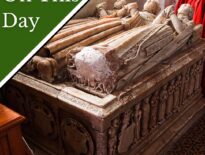On this day in Tudor history, 6th September 1572, in the reign of Queen Elizabeth I, Sir Henry Jerningham (Jernegan) died at his manor of Costessey in Norfolk. He was buried in the parish church there.
Jerningham served Henry VIII and Mary I, and his offices in Mary's reign included privy councillor, Vice-Chamberlain of the Household, and Captain of the Yeomen of the Guard. He was instrumental in helping Mary in the succession crisis of 1553.
Here are some facts about Sir Henry Jerningham:
- Jerningham was born c. 1509/10 and was the son of Edward Jerningham (Jernegan) of Somerleyton, Suffolk, and his wife, Mary Scrope.
- His parents both served Queen Catherine of Aragon, Henry VIII's first wife.
- Jerningham's father died in 1515 and his mother went on to marry Sir William Kingston, who later became Constable of the Tower of London and acted as Anne Boleyn's gaoler in 1536.
- In 1528, Jerningham began his court career when he was appointed as a sewer in the household of Princess Mary, Henry VIII's eldest daughter.
- By 1536, Jerningham had married Frances Baynham, daughter of Sir George Baynham and granddaughter of Sir William Kingston.
- Sometime after 1540, Jerningham was made one of Henry VIII's gentleman pensioners.
- In 1544, Jerningham served in Henry VIII's French campaign.
- In 1547, Jerningham was able to obtain the manor of Costessey in Norfolk.
- In July 1553, following the death of Edward VI, Jerningham helped Mary flee to East Anglia. On 15th July 1553, royal ships guarding the Eastern coast for Queen Jane swapped their allegiance to Queen Mary. Their crews had not been paid, and they received a visit from Sir Henry Jerningham asking them to support Mary instead". In "The Navy of Edward VI and Mary I", C.S. Knighton explains that "Sir Henry Jerningham (d. 1572) had been in Mary's service since 1528 and had gone at once to join her at Kenninghall; he then mustered support for her cause in Suffolk [...] Jerningham heard of the ships in the Orwell from a drunken sailor late on the night of 14 July, and found them beached at Landguard Point early next morning." Just four days after the ships swapped sides, Mary was proclaimed Queen of England.
- By 20th July 1553, Mary had appointed Jerningham as a privy councillor, vice-chamberlain, and captain of the guard. She also appointed his wife to her household and gave them lands.
- At Mary's coronation, Jerningham was made a Knight of the Bath.
- In 1554, Jerningham helped put down Wyatt's Rebellion and was a member of the jury that tried the rebel.
- In Mary's reign, Jerningham served as a knight of the shire for Suffolk then Gloucestershire.
- In December 1557, Mary I appointed Jerningham as her Master of the Horse.
- In 1558, during Mary's conflict with France, Jerningham served on her war council.
- He was one of the six executors of Mary I's will.
- Jerningham was dismissed from office on the accession of Elizabeth I in November 1558 but received a general pardon in 1559. He retired to his manor at Costessey, where he died on this day in 1572. His biographer Anne Weikel states that "his will provided for London prisoners and for almshouses founded from his lands in Herringfleet".
Also on this day in Tudor history...
Notes and Sources
- Weikel, A. (2008, January 03). Jerningham [Jernegan], Sir Henry (1509/10–1572), courtier and administrator. Oxford Dictionary of National Biography. https://www.oxforddnb.com/view/10.1093/ref:odnb/9780198614128.001.0001/odnb-9780198614128-e-14785.
- Knighton, C.S. (2011) The Navy of Edward VI and Mary I, p. 282.



Leave a Reply